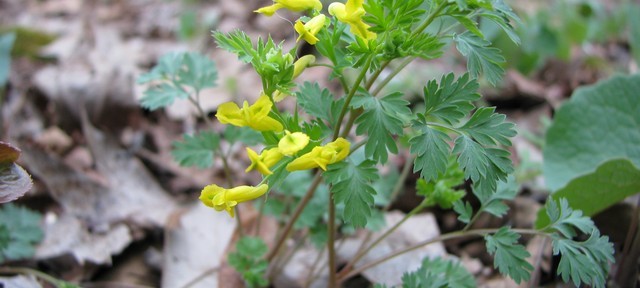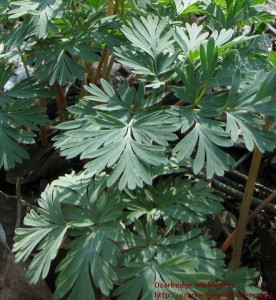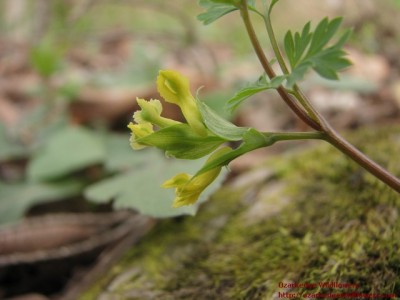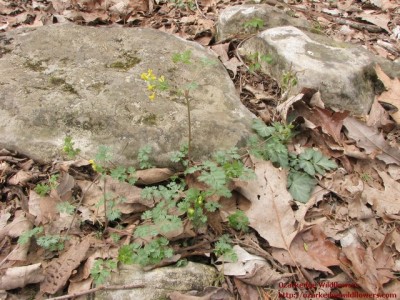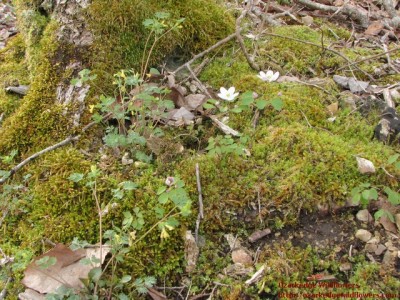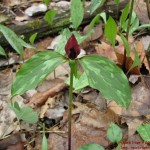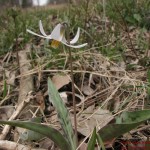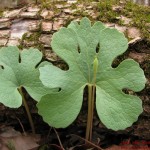I found Pale Corydalis living among Dutchman’s Breeches. I wasn’t looking for it and didn’t even realize I was seeing it until I spotted the yellow blooms just opening up. The thing is- if you don’t look carefully, the foliage of Pale Corydalis can be mistaken for Dutchman’s Breeches as they are both in the dicentra family. Once I saw the beginnings of yellow flowers, I realized I had been looking right through this pretty little plant. Pale Corydalis doesn’t get a lot of press, but the dainty blooms are lovely and the wispy, ferny look of the plant is eye-catching in the rocky landscape.
Latin Name/Common Name- The Latin name is Corydalis Flavula. Corydalis is a Greek word meaning “crested lark” referring to the spur on the flower. There are at least two plants going by the common name Pale Corydalis. It is helpful to learn the Latin names. since latin names are unique to each plant. The Pale Corydalis plant I am writing about today is a native wildflower with lemon yellow blooms. It’s other common names are Yellow Corydalis, Yellow Fumewort and Yellow Harlequin. The “other” Pale Corydalis has pink blooms. It’s Latin name is Corydalis Sempervirens. It is found in the northern US and not on Ozarkedge.
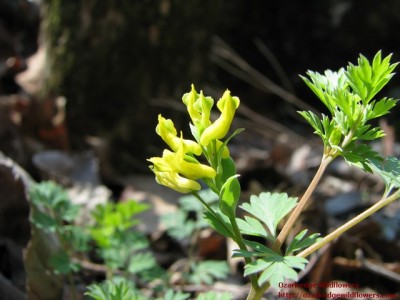
Bloom Color- The flowers of Pale Corydalis are bright lemon yellow. They really pop out in the spring woodland among all of the white and pinkish flowers. There’s a bit of green along the edge of the blooms, especially in the immature phase.
Description- Corydalis flavula grows to 12 inches tall. At first glance, the leaves resemble Dutchman’s Breeches, as the leaves of both are deeply dissected. Dutchman’s Breeches leaves are densely packed together and have a blue-green tint. Pale Corydalis stems spread out and may reach up and wave in the breeze.
The leaves in the picture above are from Dutchman’s Breeches
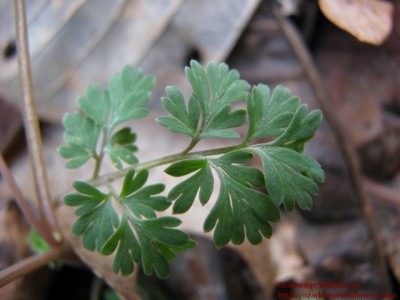
These leaves are from Pale Corydalis
Lemon yellow irregular flowers with a touch of green
The flowers grow in clusters at the ends of the stalks. Each flower has a small spur and a shape that is a bit reminiscent of snapdragon blooms. After blooming, the plant is decorative with its long, reddish seed pods. I don’t have a picture of the seed pods yet. I’ll add one as soon as I acquire it. So check back in a month or so.
Wispy, spreading plant with alternate leaves
Bloom-time- On Ozarkedge, Corydalis Flavula starts blooming in mid March and continues through April. It blooms at the same time as most spring ephemerals. Some years I find it peaking just before Dutchman’s Breeches and other years just after.
Habitat- Pale Corydalis can be found growing in rich soil in the open woodlands, usually on ridges and slopes in rocky areas.
Corydalis flavula in rocky, rich woodlands of Ozarkedge
Propagation- Shiny black seeds are found in the ornamental, long seed pod. The plant can be grown from seed.
Pale Corydalis is a winter annual. After it sets seed in the summer, the plant dies. Since it is an annual, all the plants in the wild must regenerate from seed each year. The seeds require a hot summer and wait to germinate in the fall. The seedling will arise and overwinter, blooming the next spring.
What’s Growing Neaby? As you can see from these photos, Pale Corydalis likes the company of many spring ephermals such as Dutchman’s breeches, Trilliums, Trout Lilies and Bloodroot.
Trillium recurvatum Erytrhonium albidum Sanguinaria canadensis
Endangered List- Corydalis flavula is listed as Threatened in Connecticut and Michigan. http://plants.usda.gov/java/profile?symbol=COFL3
Interesting Tidbits- If you find Pale Corydalis growing in the wild, please don’t dig. The plant is an annual and you will only disturb its habitat without gaining a live plant for yourself. Instead, mark the spot and return to save the seed. Many of our native wildflowers have become endangered due to excessive digging and loss of natural habitat.
